UML-建模设计-航-空-订-票-系-统
UML可视化建模(航空订票系统)

《可视化建模与UML》课程结业报告课题名称: 航空客运订票系统建模姓名: ***学号: *******班级:****: ***完成日期: 2013.06.16目录第一章概述 (3)1.1系统开发的摸底和开发背景 (3)1.2系统功能 (3)1.3系统结构框架 (4)1.4开发环境 (5)第二章用例模型 (6)2.1用例模型简介 (6)2.2用例图的的含义及其作用 (6)2.3用例图及用例描述 (7)第三章类模型 (10)3.1类模型简介 (10)3.2类图的作用 (10)3.3类图 (11)第四章交互模型 (13)4.1交互模型简介 (13)4.2序列图简介 (13)4.3序列图的作用 (13)4.4序列图描述及其序列图 (14)第五章行为模型 (20)5.1行为模型简介 (20)5.1.1活动图简介 (20)5.1.2活动图的作用 (20)5.1.3状态图简介 (21)5.1.4状态图的作用 (21)5.2行为模型图 (21)5.2.1活动图及其描述 (21)5.2.2状态图及其描述 (23)第六章构件图和部署图 (25)6.1构件图简介 (25)6.2部署图简介 (25)第七章课程学习小结 (27)7.1课程小结 (27)7.2学习心得 (27)参考文献 (28)第一章概述1.1系统开发的摸底和开发背景随着科技与经济的发展,越来越多的人选择乘飞机,这跟我国的经济增长有很大关系,人们在追求快节奏的生活方式,所以做飞机无疑成了首选。
而且随着网络的盛行,航空订票系统就显得尤为重要,我们开发这个系统主要是为了方便大家,让大家能够快速、清晰、准确地了解航班信息,而不至于像以前那样排队等候,从而避免耽搁乘客大量的等待时间。
航空客运业务诞生已有进一个世纪了,作为现有交通工具中最方便快捷的一种,它确实地给大家的生活、出行带来了极大的方便。
随着航空客运业务多年来的发展,其售票业务也同样不断地发展。
1.2系统功能机票预订系统是在现代社会生活节奏不断加快,对机票预订工作的自动化和准确化要求也日益强烈的背景下,为了实现机票预订工作的网络化,以及实现网络查询和统计一体化而开发的管理信息系统。
UML航空订票系统
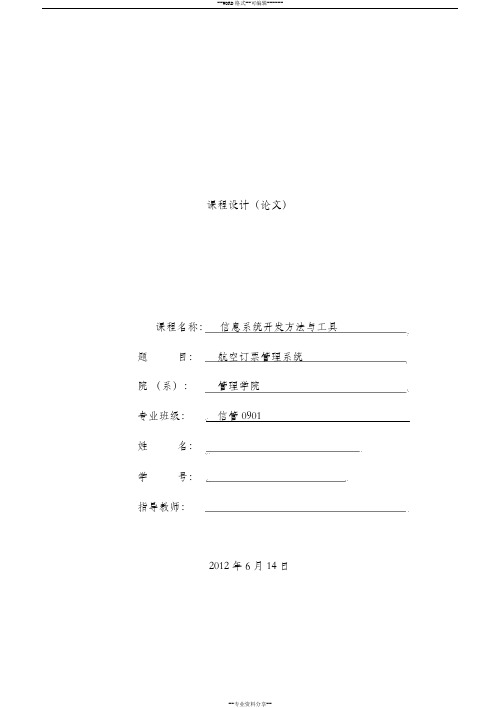
课程设计(论文)课程名称:信息系统开发方法与工具题目:航空订票管理系统院(系):管理学院专业班级:信管 0901姓名:学号:指导教师:2012 年 6 月 14 日课程设计(论文)任务书专业班级:信息管理与信息系统学生姓名:指导教师(签名):一、课程设计(论文)题目航空订票管理系统二、本次课程设计(论文)应达到的目的1.针对一个实际航空订票管理系统的开发,使学生深刻理解和掌握管理信息系统系统分析、系统设计和系统实施的理论和方法;2.巩固和加深理解所学编程语言、开发工具,提高综合应用能力;掌握系统 UML建模、界面设计、数据库设计、程序代码设计,提高实践能力;3.初步了解学术研究的基本方法与步骤,并通过设计报告(论文)的撰写,了解学术报告(论文)的写作方法。
三、本次课程设计(论文)任务的主要内容和要求(包括原始数据、技术参数、设计要求等)1、设计内容:开发出一套航空订票软件管理系统。
保证航空订票的各个环节顺利工作,并为用户提供一个友好的界面,使订票业务和管理工作相对轻松。
2、设计过程:按照系统设计目的、系统需求、系统功能分析与设计、用户界面设计、源程序设计、使用说明等环节整理课程设计的成果,形成设计报告,设计报告应包括的内容:系统需求分析:需求描述、系统 UML 主要用例、主要类图、主要活动图、状态及部署图(如果必要)、业务流程图、数据流图、数据字典附必要的文字说明系统设计:功能结构设计、 I/O 设计、代码设计、界面设计、数据库设计、网络环境。
撰写设计总结报告。
3.设计成果提交: A. 设计报告; B. 源程序。
报告要符合学校格式规范要求。
四、应收集的资料及主要参考文献:[1] 慕静等管理信息系统开发方法、工具与应用北京:清华大学出版社2010[2]商恩福网上订票系统分析与设计天津工业大学计算机科学与软件学院[3]张晓燕飞机订 /售票管理系统开发浙江工贸职业技术学院[4] 张园基于 B/S 结构的航空预订票系统的设计与实现广东海洋大学五、审核批准意见教研室主任(签字)需求说明当前航空市场的不断扩大,并且随着人们的生活水平的提高,越来越多的认选择飞机作为出行的交通工具,因此对航空公司的服务要求也就越来越高,因此为了适应这样一个快速的发展需求,管理大量数据,并有效的稳定和管理航空公司,实行现代化信息管理,无疑成为一个好的选择方式。
大学生网上订餐系统--UML建模资料讲解

大学生网上订餐系统--U M L建模题目:大学生网上订餐系统目录1背景介绍: (3)2需求分析 (3)3系统用例模型 (4)3.1订餐者用例图 (4)3.2商家用例图 (4)3.3店铺管理员用例图.............................................................. 错误!未定义书签。
3.4订单管理员用例图 (5)3.5系统管理员用例图 (6)4系统静态模型 (7)5系统动态模型 (8)5.系统时序图 (8)5.1.1订餐者订餐 (8)5.1.2商家管理店铺 (9)5.1.3店铺管理管理员管理店铺 (10)5.1.4店铺管理员建立客户评价档案 (11)5.1.5店铺管理员建立商家监察档案 (12)5.1.6订单管理员管理订单 (13)5.1.7系统管理员管理商家信息 (14)5.1.8系统管理员管理订餐者信息.................................. 错误!未定义书签。
5.1.9系统管理员维护系统 (16)5.2系统活动图 (17)5.3系统状态图 (17)6系统部署模型 (18)6.1系统构件图 (18)6.2系统部署图 (18)7总结 (19)1背景介绍随着网络技术的飞速发展,人们的生活也越来越追求方便化。
经过观察,发现整个大学城的学生对平常订餐需求很大,但他们订餐的方式都是比较原始的电话订餐。
而各个餐饮店也是各自为战,自己接电话,记录订单需求,自己配送。
这样做效率很低,利润薄,而且信息不流畅。
所以我决定为大学生提供一个平台---网上订餐系统。
在网上给申请的商家一个虚拟店面,可以在上面挂上该商家的名称,饭菜的图片和价格等信息,让订餐者可以方便地订餐,还可以对商家的餐饮进行评价,由系统生成评价档案以供其他人参考等,而商家后期只负责做饭菜并安排人配送。
此外,需要定期对商家进行卫生安全监察,生成商家监察档案,并以此为依据来决定商家的去留等。
什么是统一建模语言(UML)?

什么是统一建模语言(UML)?UML是统一建模语言的缩写,是一种标准化建模语言,由一组集成的图表组成,它开发来帮助系统和软件开发人员指定、可视化、构建和记录软件系统的工件,以及业务建模和其他非软件系统。
UML代表了在大型和复杂系统建模中已被证明是成功的最佳工程实践的集合。
UML是开发面向对象软件和软件开发过程中非常重要的一部分。
UML 主要使用图形符号来表示软件项目的设计。
使用UML帮助项目团队沟通,探索潜在的设计,并验证软件的体系结构设计。
在本文中,我们将向您详细介绍UML是什么、UML的历史以及每个UML图类型的描述,以及UML示例。
What is Unified Modeling Language (UML)?UML, short for Unified Modeling Langung of an integrated set of diagrams, developed to help system and software developers for specifying, visualizing, constructing, and documenting the artifacts of software systems, as well as for business modeling and other non-software systems. The UML represents a collection of best engineering practices that have proven successful in the modeling of large and complex systems. The UML is a very important part of developing object oriented software and the software development process. The UML uses mostly graphical notations to express the design of software projects. Using the UML helps project teams communicate, explore potential designs, and validate the architectural design of the software. In this article we will give you detailed ideas about what is UML, the history of UML and a description of each UML diagram type, along with UML examples.The Origin of UMLThe goal of UML is to provide a standard notation that can be used by all object-oriented methods and to select and integrate the best elements of precursor notations. UML has been designed for a broad range of applications. Hence, it provides constructs for a broad range of systems and activities (e.g., distributed systems, analysis, system design and deployment).UML is a notation that resulted from the unification of OMT from1.Object Modeling T echnique OMT [James Rumbaugh 1991] - was best for analysis and data-intensive information systems.2.Booch [Grady Booch 1994] - was excellent for design and implementation. Grady Booch had worked extensively with the Ada language, and had been a major player in the development of Object Oriented techniques for the language. Although the Booch method was strong, the notation was less well received (lots of cloud shapes dominated his models - not very tidy)3.OOSE (Object-Oriented Software Engineering [Ivar Jacobson 1992]) - featured a model known as Use Cases. Use Cases are a powerful technique for understanding the behaviour of an entire system (an area where OO has traditionally been weak).In 1994, Jim Rumbaugh, the creator of OMT, stunned the software world when he left General Electric and joined Grady Booch at Rational Corp. The aim of the partnership was to merge their ideas into a single, unified method (the working title for the method was indeed the "Unified Method").By 1995, the creator of OOSE, Ivar Jacobson, had also joined Rational, and his ideas (particularly the concept of "Use Cases")were fed into the new Unified Method - now called the Unified Modelling Language1. The team of Rumbaugh, Booch and Jacobson are affectionately known as the "Three Amigos"UML has also been influenced by other object-oriented notations:•Mellor and Shlaer [1998]•Coad and Yourdon [1995]•Wirfs-Brock [1990]•Martin and Odell [1992]UML also includes new concepts that were not present in other major methods at the time, such as extension mechanisms and a constraint language.History of UML1.During 1996, the first Request for Proposal (RFP) issued by the Object Management Group (OMG) provided the catalyst for these organizations to join forces around producing a joint RFP response.2.Rational established the UML Partners consortium with several organizations willing to dedicate resources to work toward a strong UML 1.0 definition. Those contributing most to the UML 1.0 definition included:o Digital Equipment Corpo HPo i-Logixo IntelliCorpo IBMo ICON Computingo MCI Systemhouseo Microsofto Oracleo Rational Softwareo TIo Unisys3.This collaboration produced UML 1.0, a modeling language that was well-defined, expressive, powerful, and generally applicable. This was submitted to the OMG in January 1997 as an initial RFP response.14.In January 1997 IBM, ObjecTime, Platinum Technology, Ptech, Taskon, Reich Technologies and Softeam also submitted separate RFP responses to the OMG. These companies joined the UML partners to contribute their ideas, and together the partners produced the revised UML 1.1 response. The focus of the UML 1.1 release was to improve the clarity of the UML 1.0 semantics and to incorporate contributions from the new partners. It was submitted to the OMG for their consideration and adopted in the fall of 1997.1 and enhanced 1.1 to 1.5, and subsequently to UML 2.1 from 01 to 06 (now the UML current version is 2.5)Why UMLAs the strategic value of software increases for many companies, the industry looks for techniques to automate the production of software and to improve quality and reduce cost and time-to-market. These techniques include componenttechnology, visual programming, patterns and frameworks. Businesses also seek techniques to manage the complexity of systems as they increase in scope and scale. In particular, they recognize the need to solve recurring architectural problems, such as physical distribution, concurrency, replication, security, load balancing and fault tolerance. Additionally, the development for the World Wide Web, while making some things simpler, has exacerbated these architectural problems. The Unified Modeling Language (UML) was designed to respond to these needs. The primary goals in the design of the UML summarize by Page-Jones in Fundamental Object-Oriented Design in UML as follows:1.Provide users with a ready-to-use, expressive visual modeling language so they can develop and exchange meaningful models.2.Provide extensibility and specialization mechanisms to extend the core concepts.3.Be independent of particular programming languages and development processes.4.Provide a formal basis for understanding the modeling language.5.Encourage the growth of the OO tools market.6.Support higher-level development concepts such as collaborations, frameworks, patterns and components.7.Integrate best practices.UML - An OverviewBefore we begin to look at the theory of the UML, we are going to take a very brief run through some of the major concepts of the UML.The first thing to notice about the UML is that there are a lot of different diagrams (models) to get used to. The reason for thisis that it is possible to look at a system from many different viewpoints. A software development will have many stakeholders playing a part.For Example:•Analysts•Designers•Coders•Testers•QA•The Customer•Technical AuthorsAll of these people are interested in different aspects of the system, and each of them require a different level of detail. For example, a coder needs to understand the design of the system and be able to convert the design to a low level code. By contrast, a technical writer is interested in the behavior of the system as a whole, and needs to understand how the product functions. The UML attempts to provide a language so expressive that all stakeholders can benefit from at least one UML diagram.Here's a quick look at each one of these 13 diagrams in as shown in the UML 2 Diagram Structure below:Structure diagrams show the static structure of the system and its parts on different abstraction and implementation levels and how they are related to each other. The elements in a structure diagram represent the meaningful concepts of a system, and may include abstract, real world and implementation concepts, there are seven types of structure diagram as follows:•Class Diagram•Component Diagram•Deployment Diagram•Object Diagram•Package Diagram•Composite Structure Diagram•Profile DiagramBehavior diagrams show the dynamic behavior of the objects in a system, which can be described as a series of changes to the system over time, there are seven types of behavior diagrams as follows:•Use Case Diagram•Activity Diagram•State Machine Diagram•Sequence Diagram•Communication Diagram•Interaction Overview Diagram•Timing DiagramWhat is a Class Diagram?The class diagram is a central modeling technique that runs through nearly all object-oriented methods. This diagram describes the types of objects in the system and various kinds of static relationships which exist between them.RelationshipsThere are three principal kinds of relationships which areimportant:1.Association - represent relationships between instances of types (a person works for a company, a company has a number of offices.2.Inheritance - the most obvious addition to ER diagrams for use in OO. It has an immediate correspondence to inheritance in OO design.3.Aggregation - Aggregation, a form of object composition in object-oriented design.Class Diagram ExampleWhat is Component Diagram?In the Unified Modeling Language, a component diagram depicts how components are wired together to form larger components or software systems. It illustrates the architectures of the software components and the dependencies between them. Those software components including run-time components, executable components also the source code components.Component Diagram ExampleWhat is a Deployment Diagram?The Deployment Diagram helps to model the physical aspect of an Object-Oriented software system. It is a structure diagram which shows architecture of the system as deployment (distribution) of software artifacts to deployment targets. Artifacts represent concrete elements in the physical world that are the result of a development process. It models the run-time configuration in a static view and visualizes the distribution of artifacts in an application. In most cases, it involves modeling the hardware configurations together with the software components that lived on.Deployment Diagram ExampleWhat is an Object Diagram?An object diagram is a graph of instances, including objects and data values. A static object diagram is an instance of a class diagram; it shows a snapshot of the detailed state of a system at a point in time. The difference is that a class diagram represents an abstract model consisting of classes and their relationships. However, an object diagram represents an instance at a particular moment, which is concrete in nature. The use of object diagrams is fairly limited, namely to show examples of data structure.Class Diagram vs Object Diagram - An ExampleSome people may find it difficult to understand the difference between a UML Class Diagram and a UML Object Diagram as they both comprise of named "rectangle blocks", with attributes in them, and with linkages in between, which make the two UML diagrams look similar. Some people may even think they are the same because in the UML tool they use both the notations for Class Diagram and Object Diagram are put inside the same diagram editor - Class Diagram.But in fact, Class Diagram and Object Diagram represent two different aspects of a code base. In this article, we will provide you with some ideas about these two UML diagrams, what they are, what are their differences and when to use each of them.Relationship between Class Diagram and Object Diagram You create "classes" when you are programming. For example, in an online banking system you may create classes like 'User', 'Account', 'Transaction', etc. In a classroom management system you may create classes like 'Teacher', 'Student', 'Assignment', etc. In each class, there are attributes and operations that represent the characteristic and behavior of the class. Class Diagram is a UML diagram where you can visualize those classes, along with their attributes, operations and theinter-relationship.UML Object Diagram shows how object instances in your system are interacting with each other at a particular state. It also represents the data values of those objects at that state. In other words, a UML Object Diagram can be seen as a representation of how classes (drawn in UML Class Diagram) are utilized at a particular state.If you are not a fan of those definition stuff, take a look at the following UML diagram examples. I believe that you will understand their differences in seconds.Class Diagram ExampleThe following Class Diagram example represents two classes - User and Attachment. A user can upload multiple attachment so the two classes are connected with an association, with 0..* as multiplicity on the Attachment side.Object Diagram ExampleThe following Object Diagram example shows you how the object instances of User and Attachment class "look like" at the moment Peter (i.e. the user) is trying to upload two attachments. So there are two Instance Specification for the two attachment objects to be uploaded.What is a Package Diagram?Package diagram is UML structure diagram which shows packages and dependencies between the packages. Modeldiagrams allow to show different views of a system, for example, as multi-layered (aka multi-tiered) application - multi-layered application model.Package Diagram ExampleWhat is a Composite Structure Diagram?Composite Structure Diagram is one of the new artifacts added to UML 2.0. A composite structure diagram is similar to a class diagram and is a kind of component diagram mainly used in modeling a system at micro point-of-view, but it depicts individual parts instead of whole classes. It is a type of static structure diagram that shows the internal structure of a class and the collaborations that this structure makes possible.This diagram can include internal parts, ports through which the parts interact with each other or through which instances of the class interact with the parts and with the outside world, and connectors between parts or ports. A composite structure is a set of interconnected elements that collaborate at runtime to achieve some purpose. Each element has some defined role in the collaboration.Composite Structure Diagram ExampleWhat is a Profile Diagram?A profile diagram enables you to create domain and platform specific stereotypes and define the relationships between them. You can create stereotypes by drawing stereotype shapes and relate them with composition or generalization through the resource-centric interface. You can also define and visualize tagged values of stereotypes.Profile Diagram ExampleWhat is a Use Case Diagram?A use-case model describes a system's functional requirements in terms of use cases. It is a model of the system's intended functionality (use cases) and its environment (actors). Use cases enable you to relate what you need from a system to how the system delivers on those needs.Think of a use-case model as a menu, much like the menu you'd find in a restaurant. By looking at the menu, you knowwhat's available to you, the individual dishes as well as their prices. You also know what kind of cuisine the restaurant serves: Italian, Mexican, Chinese, and so on. By looking at the menu, you get an overall impression of the dining experience that awaits you in that restaurant. The menu, in effect, "models" the restaurant's behavior.Because it is a very powerful planning instrument, the use-case model is generally used in all phases of the development cycle by all team members.Use Case Diagram ExampleWhat is an Activity Diagram?Activity diagrams are graphical representations of workflows of stepwise activities and actions with support for choice, iteration and concurrency. It describes the flow of control of the target system, such as the exploring complex business rules and operations, describing the use case also the business process. In the Unified Modeling Language, activity diagrams are intended to model both computational and organizational processes (i.e. workflows).Activity Diagram ExampleWhat is a State Machine Diagram?A state diagram is a type of diagram used in UML to describe the behavior of systems which is based on the concept of state diagrams by David Harel. State diagrams depict the permitted states and transitions as well as the events that effect these transitions. It helps to visualize the entire lifecycle of objects and thus help to provide a better understanding of state-based systems.State Machine Diagram ExampleWhat is a Sequence Diagram?The Sequence Diagram models the collaboration of objects based on a time sequence. It shows how the objects interact with others in a particular scenario of a use case. With the advanced visual modeling capability, you can create complex sequence diagram in few clicks. Besides, some modeling tool such as Visual Paradigm can generate sequence diagram from the flow of events which you have defined in the use case description.Sequence Diagram ExampleWhat is a Communication Diagram?Similar to Sequence Diagram, the Communication Diagram is also used to model the dynamic behavior of the use case. When compare to Sequence Diagram, the Communication Diagram is more focused on showing the collaboration of objects rather than the time sequence. They are actually semantically equivalent, so some of the modeling tool such as, Visual Paradigm allowsyou to generate it from one to the other.Communication Diagram ExampleWhat is Interaction Overview Diagram?The Interaction Overview Diagram focuses on the overview of the flow of control of the interactions. It is a variant of the Activity Diagram where the nodes are the interactions or interaction occurrences. The Interaction Overview Diagram describes the interactions where messages and lifelines are hidden. You can link up the "real" diagrams and achieve high degree navigability between diagrams inside the Interaction Overview Diagram.Interaction Overview Diagram ExampleWhat is Timing Diagram?Timing Diagram shows the behavior of the object(s) in a given period of time. Timing diagram is a special form of a sequence diagram. The differences between timing diagram and sequence diagram are the axes are reversed so that the time are increase from left to right and the lifelines are shown in separate compartments arranged vertically.Timing Diagram ExampleUML Glossary and Terms•Abstract Class - A class that will never be instantiated. An instance of this class will never exist.•Actor - An object or person that initiates events the system is involved with.•Activity: A step or action within an Activity Diagram. Represents an action taken by the system or by an Actor.•Activity Diagram: A glorified flowchart that shows the steps and decisions and parallel operations within a process, such as an algorithm or a business process.•Aggregation - Is a part of another class. Shown with a hollow diamond next to the containing class in diagrams.•Artifacts - Documents describing the output of a step in the design process. The description is graphic, textual, or some combination.•Association - A connection between two elements of a Model. This might represent a member variable in code, or theassociation between a personnel record and the person it represents, or a relation between two categories of workers, or any similar relationship. By default, both elements in an Association are equal, and are aware of each other through the Association. An Association can also be a Navigable Association, meaning that the source end of the association is aware of the target end, but not vice versa.•Association Class: A Class that represents and adds information to the Association between two other Classes.•Attributes - Characteristics of an object which may be used to reference other objects or save object state information.•Base Class: A Class which defines Attributes and Operations that are inherited by a Subclass via a Generalization relationship.•Branch: A decision point in an Activity Diagram. Multiple Transitions emerge from the Branch, each with a Guard Condition. When control reaches the Branch, exactly one Guard Condition must be true; and control follows the corresponding Transition.•Class: A category of similar Objects, all described by the same Attributes and Operations and all assignment-compatible.•Class Diagram - Shows the system classes and relationships between them.•Classifier: A UML element that has Attributes and Operations. Specifically, Actors, Classes, and Interfaces.•Collaboration: A relation between two Objects in a Communication Diagram, indicating that Messages can pass back and forth between the Objects.•Communication Diagram - A diagram that shows how operations are done while emphasizing the roles of objects.•Component: A deployable unit of code within the system.•Component Diagram: A diagram that shows relations between various Components and Interfaces.•Concept - A noun or abstract idea to be included in a domain model.•Construction Phase - The third phase of the Rational Unified Process during which several iterations of functionality are built into the system under construction. This is where the main work is done.•Dependence: A relationship that indicates one Classifier knows the Attributes and Operations of another Classifier, but isn't directly connected to any instance of the second Classifier.•Deployment Diagram: A diagram that shows relations between various Processors.•Domain -The part of the universe that the system is involved with.•Elaboration Phase - The second phase of the Rational Unified Process that allows for additional project planning including the iterations of the construction phase.•Element: Any item that appears in a Model.•Encapsulation - Data in objects is private.•Generalization - Indicates that one class is a subclass on another class (superclass). A hollow arrow points to the superclass.•Event: In a State Diagram, this represents a signal or event or input that causes the system to take an action or switch States.•Final State: In a State Diagram or an Activity Diagram, this indicates a point at which the diagram completes.•Fork: A point in an Activity Diagram where multiple parallel control threads begin.•Generalization: An inheritance relationship, in which aSubclass inherits and adds to the Attributes and Operations of a Base Class.•GoF - Gang of Four set of design patterns.•High Cohesion - A GRASP evaluative pattern which makes sure the class is not too complex, doing unrelated functions.•Low Coupling - A GRASP evaluative pattern which measures how much one class relies on another class or is connected to another class.•Inception Phase - The first phase of the Rational Unified Process that deals with the original conceptualization and beginning of the project.•Inheritance - Subclasses inherit the attributes or characterics of their parent (superclass) class. These attributes can be overridden in the subclass.•Initial State: In a State Diagram or an Activity Diagram, this indicates the point at which the diagram begins.•Instance - A class is used like a template to create an object. This object is called an instance of the class. Any number of instances of the class may be created.•Interface: A Classifier that defines Attributes and Operations that form a contract for behavior. A provider Class or Component may elect to Realize an Interface (i.e., implement its Attributes and Operations). A client Class or Component may then Depend upon the Interface and thus use the provider without any details of the true Class of the provider.•Iteration - A mini project section during which some small piece of functionality is added to the project. Includes the development loop of analysis, design and coding.•Join: A point in an Activity Diagram where multiple parallel control threads synchronize and rejoin.•Member: An Attribute or an Operation within a Classifier.•Merge: A point in an Activity Diagram where different control paths come together.•Message - A request from one object to another asking the object receiving the message to do something. This is basically a call to a method in the receiving object.•Method - A function or procedure in an object.•Model - The central UML artifact. Consists of various elements arranged in a hierarchy by Packages, with relations between elements as well.•Multiplicity - Shown in a domain model and indicated outside concept boxes, it indicates object quantity relationship to quantiles of other objects.•Navigability: Indicates which end of a relationship is aware of the other end. Relationships can have bidirectional Navigability (each end is aware of the other) or single directional Navigability (one end is aware of the other, but not vice versa).•Notation - Graphical document with rules for creating analysis and design methods.•Note: A text note added to a diagram to explain the diagram in more detail.•Object - Object: In an Activity Diagram, an object that receives information from Activities or provides information to Activities. In a Collaboration Diagram or a Sequence Diagram, an object that participates in the scenario depicted in the diagram. In general: one instance or example of a given Classifier (Actor, Class, or Interface).•Package - A group of UML elements that logically should be grouped together.•Package Diagram: A Class Diagram in which all of theelements are Packages and Dependencies.•Pattern - Solutions used to determine responsibility assignment for objects to interact. It is a name for a successful solution to a well-known common problem.•Parameter: An argument to an Operation.•Polymorphism - Same message, different method. Also used as a pattern.•Private: A Visibility level applied to an Attribute or an Operation, indicating that only code for the Classifier that contains the member can access the member.•Processor: In a Deployment Diagram, this represents a computer or other programmable device where code may be deployed.•Protected: A Visibility level applied to an Attribute or an Operation, indicating that only code for the Classifier that contains the member or for its Subclasses can access the member.•Public: A Visibility level applied to an Attribute or an Operation, indicating that any code can access the member.•Reading Direction Arrow - Indicates the direction of a relationship in a domain model.•Realization: Indicates that a Component or a Class provides a given Interface.•Role - Used in a domain model, it is an optional description about the role of an actor.•Sequence Diagram: A diagram that shows the existence of Objects over time, and the Messages that pass between those Objects over time to carry out some behavior. State chart diagram - A diagram that shows all possible object states.•State: In a State Diagram, this represents one state of a system or subsystem: what it is doing at a point in time, as wellas the values of its data.•State Diagram: A diagram that shows States of a system or subsystem, Transitions between States, and the Events that cause the Transitions.•Static: A modifier to an Attribute to indicate that there's only one copy of the Attribute shared among all instances of the Classifier. A modifier to an Operation to indicate that the Operation stands on its own and doesn't operate on one specific instance of the Classifier.•Stereotype: A modifier applied to a Model element indicating something about it which can't normally be expressed in UML. In essence, Stereotypes allow you to define your own "dialect" of UML.•Subclass: A Class which inherits Attributes and Operations that are defined by a Subclass via a Generalization relationship.•Swimlane: An element of an Activity Diagram that indicates what parts of a system or a domain perform particular Activities. All Activities within a Swimlane are the responsibility of the Object, Component, or Actor represented by the Swimlane.•Time Boxing - Each iteration will have a time limit with specific goals.•Transition: In an Activity Diagram, represents a flow of control from one Activity or Branch or Merge or Fork or Join to another. In a State Diagram, represents a change from one State to another.•Transition Phase - The last phase of the Rational Unified Process during which users are trained on using the new system and the system is made available to users.•UML - Unified Modeling Language utilizes text and graphic documents to enhance the analysis and design of software。
UML_飞机订票系统课设

《UML课程设计》报告题目:机票订票系统学号:姓名:孟瑞瑞指导老师:母丽丽日期:2015-05-281.系统概述1.1 背景当今世界,以信息技术为主要标志的科技进步日新月异,高科技成果向现实生产力的转化越来越快。
纵观全球经济发展,信息技术和信息产业已经成为经济增长的主要推动力之一,正在改变着传统的生产和经营方式以至生活方式,发达国家经过产业结构的升级和经济结构的转型已进入信息经济阶段。
信息资源已经成为国民经济和社会发展的战略资源,信息化水平也已成为现代水平和综合国力的重要标志。
党和国家已将国民经济和社会信息化放在优先发展位置,体现了先进生产力的客观要求,是一项重要的战略决策。
这是民航加快发展的机遇,更是民航信息化的难得机遇。
随着知识经济的到来,人类已经逐步进入信息化社会,信息增长的速度越来越快,人们希望利用先进的管理理论方法手段来得到并处理越来越多的信息,以提高工作效率和管理水平。
由于信息资源对人们生活的重要性,不断提高信息的收集,传输,加以利用等活动,日益成为人们社会生活的重要组成部分。
网上机票预订管理系统的产生和发展正好满足人们的这种需求。
现在将详细介绍我的课程设计——网上机票预订管理系统。
1.2 系统目标系统实现后,大大提高旅游局的机票预定服务效率。
降低售票服务中的错误发生率,减少信息交流繁琐的过程以及其带来的开销。
方便用户查询管理自己的票务信息。
1.3 系统需求规格说明1:功能需求:A:用户注册功能:该功能可以完成普通旅客注册和管理员注册任务。
B:用户信息维护功能:该功能可以完成普通旅客和管理员根据实际情况,对自己的信息进行更新操作。
C:用户功能:C1:机票查询功能:该功能为用户提供简洁的页面呈现,方便用户根据自己的需要选择自己需要的机票。
C2:机票预定功能:该功能为用户提供简洁的页面呈现,方便用户根据自己的需要预定机票。
C3:退票功能:该功能,功能为用户提供简洁的页面呈现,为用户提供退票功能。
航空公司管理系统(uml建模)
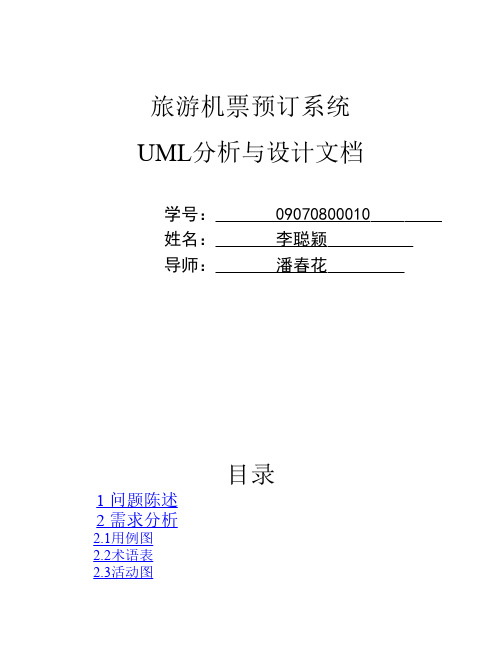
旅游机票预订系统UML分析与设计文档学号: 09070800010姓名: 李聪颖导师: 潘春花目录1 问题陈述2 需求分析2.1用例图2.2术语表2.3活动图2.3.1输入航线信息活动图2.4用例规约2.4.1用例规约Login2.4.2用例规约用户管理2.4.3用例规约航线信息管理2.4.4用例规约客户信息管理2.4.5用例规约订票信息管理3 分析与设计3.1架构分析3.1.1 界面层3.1.2管理逻辑层3.1.3 数据库层3.2 关键抽象3.3 用例实现3.3.1 输入航线信息的用例实现4 用例分析4.1分析类4.2分析类的功能4.2.1 airline类4.2.2 plane类4.2.3 service类4.2.4 customerType类4.2.5 customer类4.2.6 ticket类4.3 类图及类之间的关联4.4数据库设计4.4.1 user_info1 管理用户信息表4.4.2 serviceInfo 舱位等级信息表4.4.3 planeInfo客机信息表格4.4.4 airlineInfo航线信息表4.4.5 customerType 客户类型信息表4.4.6 customerInfo 客户信息表4.4.7 ticketInfo 订票信息表4.4.8 数据库结构及各表间的关系1 问题陈述本小组项目任务是开发一个旅游订票管理系统,需要管理客户的信息,提供票务管理。
面对各种不同种类的信息,需要合理的数据库结构来保存数据信息以及有效的程序结构支持各种数据操作的执行。
本系统包括系统管理,客户信息管理,订票信息管理等功能。
系统开发的总体任务是实现各种信息的系统化、规范化和自动化。
系统设系统管理角色有:系统管理员,负责监控整个系统的运行,添加和删除一般用户,对数据进行添加,修改,删除,查询。
系统允许舱位信息的输入和修改,包括舱位等级编号、舱位等级名称、提供的各种服务类别,以及备注信息等。
6.5.2 绘制机票预订系统的类图[共4页]
![6.5.2 绘制机票预订系统的类图[共4页]](https://img.taocdn.com/s3/m/b9e8eb0749649b6649d74741.png)
97 择所要生成的源文件并选择【OK 】即可。
此时若模型有错误,Rose 会给出相应的错误和警告信
息并显示在日志区,用户需要更正错误后再次生成即可。
图6-42 生成Java 代码 图6-43 指定CLASSPATH 条目对话框 6.5.2 绘制机票预订系统的类图
为了使读者更好地理解类图,我们仍然假设了一个具体情境,展示项目分析阶段的类图的主要创建过程。
系统的具体情景说明请参考5.7.2小节。
1.确定类元素
根据情境描述,我们应该确定出系统主要可以包括哪些类。
在本题中,我们可以归结出用户、管理员、机场、航班与机票几个实体类,还应该包括有一个系统控制类来控制整个系统。
由于分析阶段尚未进行用户界面设计,因此类图中暂时不涉及边界类,需要在设计阶段再对类图进一步完善。
将确定好的类添加到类图中,如图
6-44
所示。
图6-44 确定类元素。
UML建模设计航空订票系统
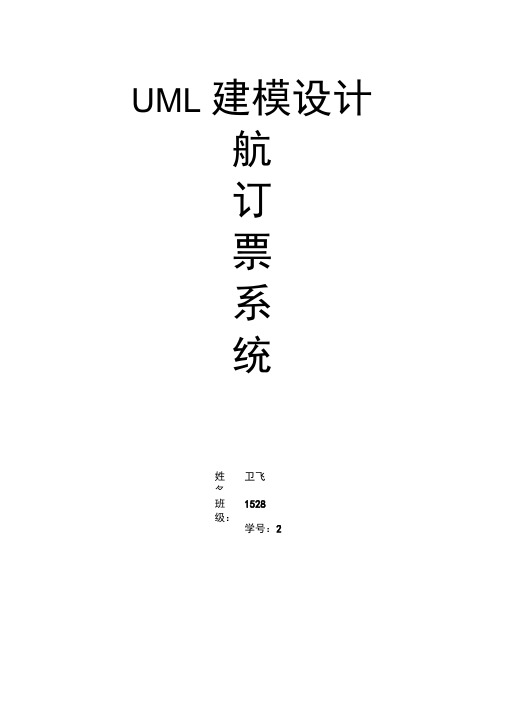
UML 建模设计航订票系统卫飞姓名:班1528级:学号:2一、背景1.1 背景概述随着知识经济的到来,人类已经逐步进入信息化社会,信息增长的速度越来越快,人们希望利用先进的管理理论方法手段来得到并处理越来越多的信息,以提高工作效率和管理水平。
由于信息资源对人们生活的重要性,不断提高信息的收集,传输,加以利用等活动,日益成为人们社会生活的重要组成部分。
网上机票预订管理系统的产生和发展正好满足人们的这种需求1.2 主要组成及功能1、新用户注册,新用户可以注册,注册时输入用户名可以查询用户可不可用,可用就可以注册,注册时可以判断用户输入的密码和验证密码是否相同,相同才给以注册,如果满意可以点注册,注册成功后用户可以选择不用在回到登陆界面,可以直接陆到用户主界面,以后就可以用这个用户登录了,如果不满意,点取消,所有信息清空,重新输入。
2、验证登陆名密码,正确进入主菜单,根据登录时所选的登录方式(客户、管理员)的不同分别对用户设定不同的访问权限(如果是输入的客户用户名和密码正确,选择以客户方式登陆则主界面里面的管理员界面不能用,如果输入的是管理员的相应用户密码正确,以管理员的方式登陆则管理员界面可用)不正确则清空登录框,最多可以输入三次,三次不正确系统会自动关闭3. 我的航班界面。
你可以点击你想查询的有关机票的信息的按钮(舱位信息查询,客机信息查询,航线查询,客户类型信息查询)获得相关信息的表,根据表的内容,你可以在下面的下拉框中选择你要定的票信息,点确定后在下面会显示你的机票的相关内容,如果满意可以点击订票,把相关信息添加到机票数据库表中,如果不满意,可以点重置,所有信息清空,再重新选择。
4. 退票功能。
用户可以根据用户信息表中的我的机票信息查询,找出机票号,在输入到机票号查询里,点击查询获得你的机票信息以及价格显示,点击退票则在数据库机票信息表中删除本条信息二、使用Rose 绘制图分别有:用例图、类图、包图、顺序图、协作图、状态图、活动图、组件图、部署图情景:机票预订系统是某航空公司推出的一款网上选票系统。
航空公司管理系统(uml建模)
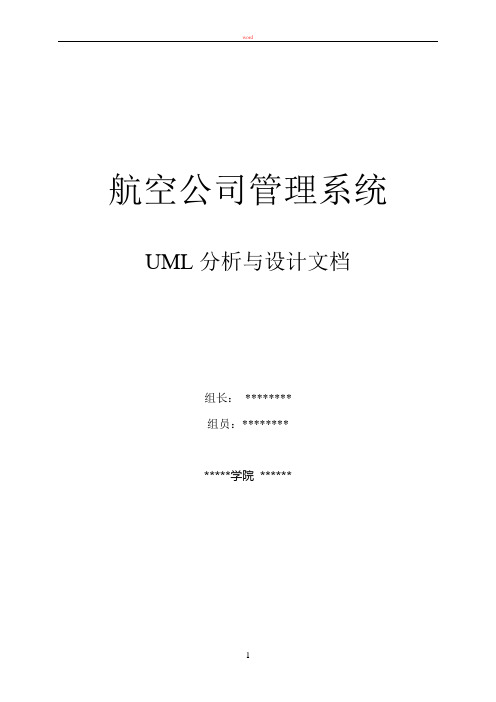
航空公司管理系统UML分析与设计文档组长:********组员:*************学院******目录目录 (2)1 问题陈述 (3)2 需求分析 (4)2.1用例图 (4)2.2术语表 (6)2.3活动图 (6)2.3.1输入航线信息活动图 (6)2.4用例规约 (7)2.4.1用例规约Login (7)2.4.2用例规约用户管理 (8)2.4.3用例规约航线信息管理 (8)2.4.4用例规约客户信息管理 (9)2.4.5用例规约订票信息管理 (9)3 分析与设计 (10)3.1架构分析 (10)3.1.1 界面层 (10)3.1.2管理逻辑层 (11)3.1.3 数据库层 (11)3.2 关键抽象 (11)3.3 用例实现 (11)3.3.1 输入航线信息的用例实现 (11)4 用例分析 (13)4.1分析类 (13)4.2分析类的功能 (13)4.2.1 airline类 (13)4.2.2 plane类 (13)4.2.3 service类 (13)4.2.4 customerType类 (14)4.2.5 customer类 (14)4.2.6 ticket类 (14)4.3 类图及类之间的关联 (14)4.4数据库设计 (15)4.4.1 user_info1 管理用户信息表 (15)4.4.2 serviceInfo 舱位等级信息表 (15)4.4.3 planeInfo客机信息表格 (15)4.4.4 airlineInfo航线信息表 (16)4.4.5 customerType 客户类型信息表 (16)4.4.6 customerInfo 客户信息表 (16)4.4.7 ticketInfo 订票信息表 (16)4.4.8 数据库结构及各表间的关系 (17)1 问题陈述本小组项目任务是开发一个航空公司管理系统。
一个正常营运的航空公司需要管理所拥有的飞机、航线的设置、客户的信息等,更重要的还要提供票务管理。
绘制机票预订系统的用例图_UML与Rose建模实用教程_[共2页]
![绘制机票预订系统的用例图_UML与Rose建模实用教程_[共2页]](https://img.taocdn.com/s3/m/617b2ce6b90d6c85ed3ac647.png)
685.7.2 绘制机票预订系统的用例图为了加深读者对用例图概念与Rose操作的理解,本小节从一个具体情境出发,展示一个用例图的创建过程。
下面就以某机票预订系统为例进行相关说明[1]。
1.情境说明机票预订系统是某航空公司推出的一款网上购票系统。
其中,未登录的用户只能查询航班信息,已登录的用户还可以网上购买机票,查看已购机票,也可以退订机票。
系统管理员可以安排系统中的航班信息。
此外,该购票系统还与外部的一个信用评价系统有交互。
当某用户一个月之内退订两次及以上的机票时,需要降低该用户在信用评价系统中的信用等级。
当信用等级过低时,则不允许该用户再次购买机票。
2.确定参与者在了解完系统语境后,首先应该分析确定系统中的参与者。
根据系统的背景说明,我们可以分析出需要订票的用户肯定要参与其中,并且用户根据是否已登录有不同的系统使用权限。
负责安排航班信息的管理员和与系统产生交互的外部信用评价系统也应该属于系统的参与者。
通过以上分析可以得出,系统主要由三类参与者,分别是用户、管理员与信用评价系统。
其中,用户包括游客与注册用户,表示为参与者的泛化关系。
由于用户一定属于二者其中之一,故用户应该是一个抽象参与者。
将参与者画到用例图中,如图5-17所示。
图5-17 确定参与者3.确定用例我们已经分析出系统中的参与者,然后就可以通过分析每个参与者是如何使用系统来确定系统中的用例。
在本系统中,游客可以注册系统和查询航班信息;注册用户可以登录系统、查询航班信息、购买机票、查看行程和退订机票;管理员可以登录系统和设定航班安排;信用评价系统可以修改和检查信用等级。
需要注意的是,修改和检查信用等级的用例并非是由信用评价系统主动触发的,信用评价系统对这两个用例而言只是副参与者。
将用例添加到用例图中并与其参与者之间建立关联关系,如图5-18所示。
[1] 本书中第5~13章的最后一小节均采用这一设想的情境来进行实例讲解。
机票订票系统UML

等众多图…
总结
对UML更 加理解了
可以有效地共享 和交流设计成果
让自己的系 统更加清晰
UML各类图可以让大脑有个明了的框图
飞机机票 订订票票系系统统
系统需求规格说明
功能需求: A:用户注册功能 B:用户信息维护功能
用户功能: C1:机票查询功能 C2:机票预定功能 C3:退票功能
管理员功能: D1:票务信息维护功能 D2:飞机信息维护功能 D3:用户信息维护功能
性能需求: E1:系统处理的准确性和及时性 E2:系统的开放性和可扩展性 E3: 提供良好的用户接口
整个系统状 态图
System admin
login Search fight information Search ticket information Add fight Delete fight
System admin
售票员订票的详细流程, 先登录,然后应要求, 可以对之前已订的票选 择退票或者根据航班信 息或者根据票量搜寻满 足条件的票,如果有满 足条件的就显示出来, 然后进行订票,打印单 据,结束
[按航班查询]
Search fight information
主要实现对航班的增,删,改
Login
等更新操作
[按余额查询]
Search ticket information flight
Delete flight
Change flight
从登陆开始,到搜索满足条 件的票进行订票,付款。
航空订票系统-uml建模设计
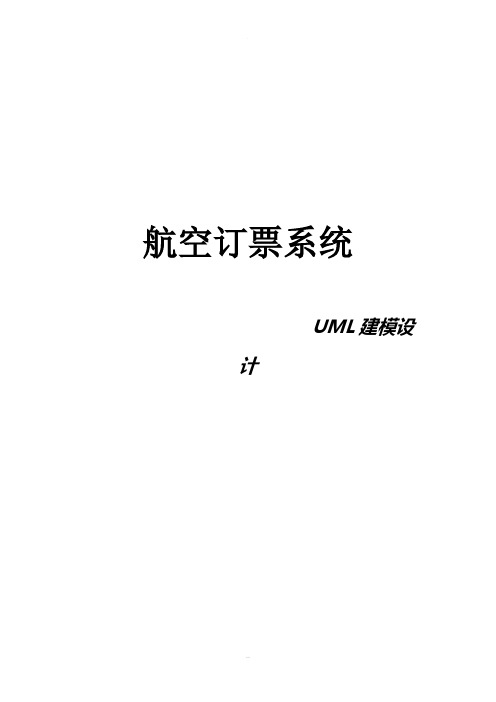
航空订票系统UML建模设计20117760XXX金振方鉴于当今互联网行业的飞速发展,网络用户的日渐增多,对互联网应用的需求日益强烈,某航空公司欲开发一套航空管理系统,以下内容为管理系统中订票子系统的UML建模设计:1.需求系统需求如下:1.该订票系统的浏览用户被划分为游客(即未注册用户)与用户(即注册用户),未注册用户只能访问该系统的首页,首页提供登录功能和前往注册按钮,用户可以登录或者前往注册。
2.用户登录成功后,前往航班查询页面,进行航班信息的查询,当欲订航班存在时可以进行订票。
3.用户可以查看自身所有预定的航班票,并在一定条件下(即航班未发出)可以进行退票和付款。
4.该系统的管理员可以对航班信息进行增删查改,并负责航班信息的更新。
5.用户可以登入系统进行票据的打印。
6.权限验证,即用户与管理员身份的区别验证。
附录:该系统的核心与主要的功能模块分为查询模块和订票模块,直接用户为管理员和注册用户,管理员登入系统后负责信息的更新与修改,并且审核错误的信息。
注册用户登入系统后,可以进行航班查询操作,待查询到欲订的航班信息时,可以进行订票,订票完成后可以进行付款,并且可以到相关页面查看预定的所有的机票的信息,与付款情况,并可在当前页面进行退票或者付款,还可进行票据的打印,以及对订票的个人信息的修改。
管理员用户的注册为特殊用户注册,由系统的最高权限的管理员分派标识符或者由航空公司内部员工号进行区别鉴定,管理员登入系统时与普通注册用户相同,但进行敏感操作时,比如点击航班信息添加或修改时需要进行身份验证,此时需要输入当时由系统最高权限的管理员派发的标识符(或其他)进行验证。
系统用例如下:根据系统功能的区别,系统分为订票模块与航班信息管理模块还有个人信息管理模块,订票模块主要由查票,订票,退票,改票等功能组成。
航班信息管理模块主要由航班信息的增删查改等功能组成。
个人信息管理模块主要由个人信息的查询,修改等功能组成。
UML建模课程设计(史上最全)

UML建模课程设计目录1 引言 (4)2 UML概述 (4)2.1 UML简介 (4)2.2 UML模型图的构成 (5)2.3 UML事物 (5)2.3.1 构件事物 (5)2.3.2 行为事物 (6)2.3.3 分组事物 (6)2.3.4 注释事物 (6)2.4 UML图及特征 (6)2.4.1 用例图 (6)2.4.2 类图 (7)2.4.3 对象图 (7)2.4.4 时序图 (7)2.4.5 协作图 (7)2.4.6状态图 (8)2.4.7活动图 (8)2.4.8组件图 (8)2.4.9配置图 (9)3 UML结合实例分析 (9)3.1 需求分析 (9)3.1.1系统开发需求 (9)3.1.2系统功能需求 (9)3.2 UML建模分析 (10)3.2.2类图 (11)3.2.3 活动图 (12)3.2.4 顺序图 (13)3.2.5 协作图 (15)3.2.6 状态图 (16)3.2.7 组件图 (17)3.2.8 部署图 (18)4 总结 (19)1 引言建模是开发优秀软件所有活动的核心部分。
在开发中利用UML来编制系统蓝图,并与仓库管理系统开发的特色相结合,提出了自己的一套UML的建模过程。
基于这个过程来进行系统的分析,设计,实现与测试。
运用UML建模思想与各种模型对仓库管理系统进行详细的描述。
2 UML概述2.1 UML简介UML (Unified Modeling Language)为面向对象软件设计提供统一的、标准的、可视化的建模语言。
适用于描述以用例为驱动,以体系结构为中心的软件设计的全过程。
UML的定义包括UML语义和UML表示法两个部分。
UML语义:UML对语义的描述使开发者能在语义上取得一致认识,消除了因人而异的表达方法所造成的影响。
UML表示法:UML表示法定义UML符号的表示法,为开发者或开发工具使用这些图形符号和文本语法为系统建模提供了标准。
2.2 UML模型图的构成事物(Things):UML模型中最基本的构成元素,是具有代表性的成分的抽象关系(Relationships):关系把事物紧密联系在一起图(Diagrams ):图是事物和关系的可视化表示2.3 UML事物UML语言的事物,包括四类:结构事物:语言的静态构成要素,有7种:类和对象、接口、主动类、用例、协作、构件、节点。
UML建模案例——酒店预订系统

UML建模案例——酒店预订系统酒店预订系统的UML建模案例如下:一、系统概述酒店预订系统是一个用于帮助客户预订酒店房间的在线系统。
该系统允许客户浏览可用酒店,并选择适合他们需求的房间。
客户还可以选择入住和退房日期,以及其他附加服务和设施。
一旦客户完成预订,酒店管理员将收到通知并确认预订。
该系统还提供了一些管理工具,使管理员能够管理客户预订、酒店信息和房间库存。
二、系统用例图系统用例图描述了酒店预订系统的主要功能和参与者之间的交互。
主要参与者包括客户和酒店管理员。
1.客户客户可以执行以下操作:-酒店:客户可以根据地点、日期、房间类型等条件可用的酒店。
-查看酒店信息:客户可以查看特定酒店的详细信息,包括房间类型、设施、服务等。
-预订房间:客户可以选择适合他们需求的房间,并选择入住和退房日期以及其他附加服务和设施进行预订。
2.酒店管理员酒店管理员可以执行以下操作:-管理房间:管理员可以添加、更新和删除酒店的房间信息,包括房间类型、价格、可用数量等。
-管理预订:管理员可以查看客户的预订情况,并确认、取消或修改预订。
三、系统类图系统类图描述了酒店预订系统中的主要类和它们之间的关系。
1.类主要类包括以下几类:-房间:表示酒店中的房间,包括房间类型、价格和可用数量。
-预订:表示客户的预订,包括预订日期、入住日期和退房日期。
-管理员:表示系统中的管理员,包括管理员的姓名、用户名和密码。
2.关系主要关系包括以下几种:-关联关系:表示类之间的关联,例如客户与预订之间的关联,酒店与房间之间的关联。
-继承关系:表示类之间的继承关系,例如客户和管理员都继承自用户类。
-依赖关系:表示类之间的依赖关系,例如客户依赖于酒店类和房间类。
四、系统顺序图系统顺序图描述了酒店预订系统中的一些典型操作流程。
1.客户预订酒店客户首先可用的酒店,然后查看并选择适合他们需求的房间。
然后,客户提供入住和退房日期,并选择其他附加服务和设施进行预订。
航空公司管理系统(uml建模)
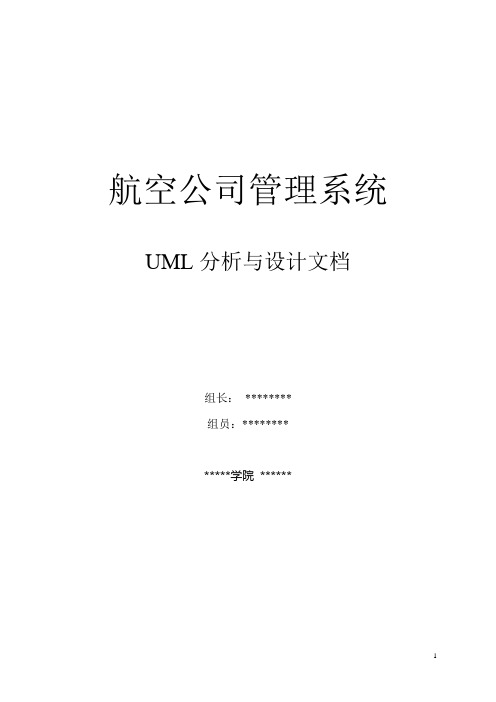
基本流程3(主要成功场景)
输入用户名或密码不正确:
1)统显示错误信息
2)提示用户重新输入
2.4.
表2.4-2.用例规约用户管理
主要参与者
系统管理员
前置条件
系统管理员进入用户管理界面
后置条件(成功后的保证)
查询、添加、删除用户信息成功
基本流程(主要成功场景)
1)显示所以一般员工的信息
2)添加用户
3)删除用户
4)系统管理员输入查询的关键字,按下查询按钮
4.4.3 planeInfo客机信息表格16
4.4.4 airlineInfo航线信息表16
4.4.5 customerType客户类型信息表16
4.4.6 customerInfo客户信息表17
4.4.7 ticketInfo订票信息表17
4.4.8数据库结构及各表间的关系17
1
本小组项目任务是开发一个航空公司管理系统。一个正常营运的航空公司需要管理所拥有的飞机、航线的设置、客户的信息等,更重要的还要提供票务管理。面对各种不同种类的信息,需要合理的数据库结构来保存数据信息以及有效的程序结构支持各种数据操作的执行。本系统对航空公司的内部运作进行管理,包括系统管理,航线信息管理,客户信息管理,订票信息管理等功能。系统开发的总体任务是实现各种信息的系统化、规范化和自动化。
2.4.4用例规约客户信息管理9
2.4.5用例规约订票信息管理9
3分析与设计10
3.1架构分析10
3.1.1界面层10
3.1.2管理逻辑层11
3.1.3数据库层11
3.2关键抽象11
3.3用例实现11
3.3.1输入航线信息的用例实现11
4用例分析13
航空订票系统-uml建模设计学习资料

航空订票系统UML建模设计20117760XXX金振方鉴于当今互联网行业的飞速发展,网络用户的日渐增多,对互联网应用的需求日益强烈,某航空公司欲开发一套航空管理系统,以下内容为管理系统中订票子系统的UML建模设计:1.需求系统需求如下:1.该订票系统的浏览用户被划分为游客(即未注册用户)与用户(即注册用户),未注册用户只能访问该系统的首页,首页提供登录功能和前往注册按钮,用户可以登录或者前往注册。
2.用户登录成功后,前往航班查询页面,进行航班信息的查询,当欲订航班存在时可以进行订票。
3.用户可以查看自身所有预定的航班票,并在一定条件下(即航班未发出)可以进行退票和付款。
4.该系统的管理员可以对航班信息进行增删查改,并负责航班信息的更新。
5.用户可以登入系统进行票据的打印。
6.权限验证,即用户与管理员身份的区别验证。
附录:该系统的核心与主要的功能模块分为查询模块和订票模块,直接用户为管理员和注册用户,管理员登入系统后负责信息的更新与修改,并且审核错误的信息。
注册用户登入系统后,可以进行航班查询操作,待查询到欲订的航班信息时,可以进行订票,订票完成后可以进行付款,并且可以到相关页面查看预定的所有的机票的信息,与付款情况,并可在当前页面进行退票或者付款,还可进行票据的打印,以及对订票的个人信息的修改。
管理员用户的注册为特殊用户注册,由系统的最高权限的管理员分派标识符或者由航空公司内部员工号进行区别鉴定,管理员登入系统时与普通注册用户相同,但进行敏感操作时,比如点击航班信息添加或修改时需要进行身份验证,此时需要输入当时由系统最高权限的管理员派发的标识符(或其他)进行验证。
系统用例如下:根据系统功能的区别,系统分为订票模块与航班信息管理模块还有个人信息管理模块,订票模块主要由查票,订票,退票,改票等功能组成。
航班信息管理模块主要由航班信息的增删查改等功能组成。
个人信息管理模块主要由个人信息的查询,修改等功能组成。
苏州科技学院UML建模技术案例
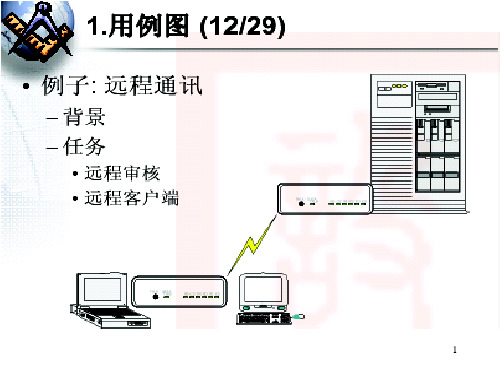
Credit System
(from Actor)
Flight Coordinator
(from Actor)
62
Airline
案例1:航空售票系统
Purchase Ticket Check credit Change Reservation
Credit System
(from Actor)
58
识别思路:
• • • • • • • • • 谁使用该系统 谁改变系统的数据 谁从系统获取信息 谁需要系统的支持以完成日常工作任务
操作员,管理员 操作员,管理员 操作员,管理员
领料员,退料员,操作员,管理员,供应商
谁负责维护、管理并保持系统正常运行案 管理员 系统需要应付那些硬件设备 生产系统, 供应商系统 系统需要和那些外部系统交互 操作员,管理员,领料员,退料员 谁对系统运行产生的结果感兴趣 时间、气温等内部外部条件 时间
(from Actor)
Flight Coordinator
(from Actor)
57
Airline
案例2:库存管理系统
某汽车制造厂需要一套库存管理系统, 该系统实现的业务:生产工人根据生 产计划领取物料,库存操作员根据生 产系统的派单准备,交付给领料工人, 余料即时归还库房。库房管理人员定 期盘点库存,通知供应商供货,对长 期积存的货物,申请退货。
75
76
练习: 建模航班状态图 创建一个状态图来描述航班如何从提出申请、制定航班计划、 售票、起飞、飞行、到着陆的状态过程。 练习步骤; 1)标识出要建模的实体。 2)标识出实体的状态。
77
航班计划 批准航班计划 航班申请
entry/ 发 布 航 班 信 息 do/ 检 查 当 前 日 期
机票预订系统UML

一、介绍1.简介随着现在社会的发展,人民生活水平的不断提高,人们出行的交通工具也跟随社会的发展而发展起来了,乘飞机出行的人越来越多,对航空公司的服务要求也就越来越高,所以这方面的市场非常大。
“机票预定系统”的开发是势在必行。
因此为了适应这样一个快速的发展需求,管理大量数据,并有效的稳定和管理航空公司,实行现代化信息管理,无疑成为一个好的选择方式。
在此基础上确定了顾客与各航空公司所需要的“机票预定统”。
系统最终实现有预定订票、查询预定信息、删除预定信息、处理预定信息、航班信息的添加、航班信息的删除、航班信息的查询等一系列所设机航空的的最基本的功能。
与此同时我会不断更新系统的功能最终使系统更加完美。
本系统通过初期的需求分析,建立了严密的数据逻辑结构以及数据库设计所涉及的严格的编码规范、最终是其数据库达到三范式。
让系统更加适合数据库设计的要求。
并使其在后面的系统实施阶段更加方便快捷,在系统维护和运行阶段尽量出现少的错误。
让系统能够全面正常运转。
让系统更加人性化更加方便用户使用。
2.需求分析2.1功能分析2.1.1订票功能:该功能为用户提供简洁的页面呈现,方便用户根据自己的需要预定机票。
2.1.2退票功能:该功能为用户提供简洁的页面呈现,为用户提供退票功能。
2.1.3查询票据信息功能:该功能为用户提供简洁的页面呈现,为用户提供查询票据信息。
2.1.4航班预定功能:该功能为用户提供简洁的页面呈现,用户能够进行航班预定。
2.1.5生成订票列表功能:系统根据用户订票信息生成订票列表。
2.1.6生成退票信息功能:系统根据用户退票操作生成退票信息。
2.1.7处理订票功能:通过该功能,管理员可以处理用户预定的机票,根据航班信息,更改用户实际订票信息。
2.1.8添加航班信息功能:通过该功能,管理员可以将新的航班信息进行更改,以方便用户能够查询到新的航班信息。
2.1.9修改航班信息功能:过该功能,管理员可以依照时时的航班情况对航班信息进行修改,更新实际航班信息,以方便用户预定机票。
UML-建模设计-航-空-订-票-系-统
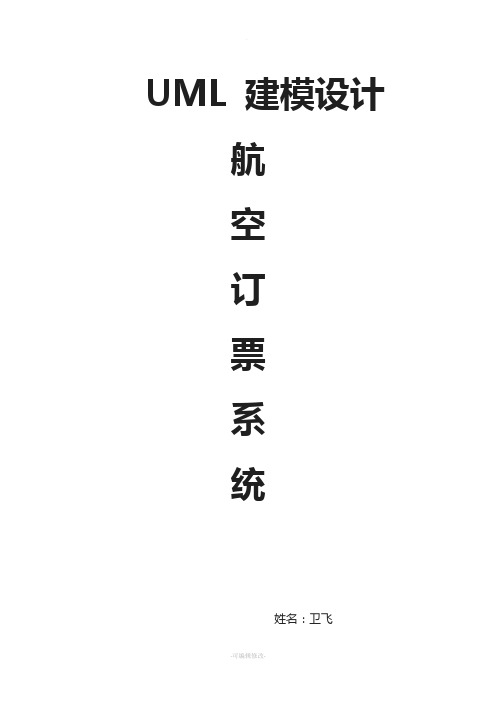
UML 建模设计航空订票系统姓名:卫飞班级:1528学号:201515614375一、背景1.1背景概述随着知识经济的到来,人类已经逐步进入信息化社会,信息增长的速度越来越快,人们希望利用先进的管理理论方法手段来得到并处理越来越多的信息,以提高工作效率和管理水平。
由于信息资源对人们生活的重要性,不断提高信息的收集,传输,加以利用等活动,日益成为人们社会生活的重要组成部分。
网上机票预订管理系统的产生和发展正好满足人们的这种需求1.2 主要组成及功能1、新用户注册,新用户可以注册,注册时输入用户名可以查询用户可不可用,可用就可以注册,注册时可以判断用户输入的密码和验证密码是否相同,相同才给以注册,如果满意可以点注册,注册成功后用户可以选择不用在回到登陆界面,可以直接陆到用户主界面,以后就可以用这个用户登录了,如果不满意,点取消,所有信息清空,重新输入。
2、验证登陆名密码,正确进入主菜单,根据登录时所选的登录方式(客户、管理员)的不同分别对用户设定不同的访问权限(如果是输入的客户用户名和密码正确,选择以客户方式登陆则主界面里面的管理员界面不能用,如果输入的是管理员的相应用户密码正确,以管理员的方式登陆则管理员界面可用)不正确则清空登录框,最多可以输入三次,三次不正确系统会自动关闭3.我的航班界面。
你可以点击你想查询的有关机票的信息的按钮(舱位信息查询,客机信息查询,航线查询,客户类型信息查询)获得相关信息的表,根据表的内容,你可以在下面的下拉框中选择你要定的票信息,点确定后在下面会显示你的机票的相关内容,如果满意可以点击订票,把相关信息添加到机票数据库表中,如果不满意,可以点重置,所有信息清空,再重新选择。
4.退票功能。
用户可以根据用户信息表中的我的机票信息查询,找出机票号,在输入到机票号查询里,点击查询获得你的机票信息以及价格显示,点击退票则在数据库机票信息表中删除本条信息二、使用Rose绘制图分别有:用例图、类图、包图、顺序图、协作图、状态图、活动图、组件图、部署图情景:机票预订系统是某航空公司推出的一款网上选票系统。
- 1、下载文档前请自行甄别文档内容的完整性,平台不提供额外的编辑、内容补充、找答案等附加服务。
- 2、"仅部分预览"的文档,不可在线预览部分如存在完整性等问题,可反馈申请退款(可完整预览的文档不适用该条件!)。
- 3、如文档侵犯您的权益,请联系客服反馈,我们会尽快为您处理(人工客服工作时间:9:00-18:30)。
UML 建模设计航空订票系统姓名:卫飞班级:1528学号:201515614375一、背景1.1背景概述随着知识经济的到来,人类已经逐步进入信息化社会,信息增长的速度越来越快,人们希望利用先进的管理理论方法手段来得到并处理越来越多的信息,以提高工作效率和管理水平。
由于信息资源对人们生活的重要性,不断提高信息的收集,传输,加以利用等活动,日益成为人们社会生活的重要组成部分。
网上机票预订管理系统的产生和发展正好满足人们的这种需求1.2 主要组成及功能1、新用户注册,新用户可以注册,注册时输入用户名可以查询用户可不可用,可用就可以注册,注册时可以判断用户输入的密码和验证密码是否相同,相同才给以注册,如果满意可以点注册,注册成功后用户可以选择不用在回到登陆界面,可以直接陆到用户主界面,以后就可以用这个用户登录了,如果不满意,点取消,所有信息清空,重新输入。
2、验证登陆名密码,正确进入主菜单,根据登录时所选的登录方式(客户、管理员)的不同分别对用户设定不同的访问权限(如果是输入的客户用户名和密码正确,选择以客户方式登陆则主界面里面的管理员界面不能用,如果输入的是管理员的相应用户密码正确,以管理员的方式登陆则管理员界面可用)不正确则清空登录框,最多可以输入三次,三次不正确系统会自动关闭3.我的航班界面。
你可以点击你想查询的有关机票的信息的按钮(舱位信息查询,客机信息查询,航线查询,客户类型信息查询)获得相关信息的表,根据表的内容,你可以在下面的下拉框中选择你要定的票信息,点确定后在下面会显示你的机票的相关内容,如果满意可以点击订票,把相关信息添加到机票数据库表中,如果不满意,可以点重置,所有信息清空,再重新选择。
4.退票功能。
用户可以根据用户信息表中的我的机票信息查询,找出机票号,在输入到机票号查询里,点击查询获得你的机票信息以及价格显示,点击退票则在数据库机票信息表中删除本条信息二、使用Rose绘制图分别有:用例图、类图、包图、顺序图、协作图、状态图、活动图、组件图、部署图情景:机票预订系统是某航空公司推出的一款网上选票系统。
其中,未登陆用户只能查询航班信息;以登陆的用户还可以网上购买机票,查看已购买机票,也可以退定机票;系统管理员可以安排系统中的航班信息。
此外,该购票系统还可以与外部的一个信用评价系统有交互。
当某用户一个月之内退订两次及以上的机票时,需要降低该用户在信用评价系统中的等级。
当信用等级过低时,则不允许用户再次购买机票。
1.用例图用例图是被称为参与者的外部用户所能观察到的系统功能的模型图。
用例是系统中的一个功能单元,可以被描述为参与者与系统之间的一次交互作用,并显示那个参与者参与了哪个用例的执行。
该用例图中角色模型有已经登录用户,未登陆用户,管理员三者构成。
已登录用户与登录系统存在着直接的通信关系;未登陆用户与查询信息之间存在着通信关系;管理员与安排航班信息之间存在着通信关系。
而登录系统又包含了:购买机票、查看机票、退定机票三者。
购买在与评价系统的继续购买与禁止购买之间存在着扩展关系。
2.类图类图是以类为中心的,类图通过显示出系统的类以及这些类之间的关系来表示系统。
订票系统的属性为class 和航班信息,已登录用户的属性为姓名身份证和电话,操作为权限,预定,撤销,查看。
未登陆用户的属性有姓名,操作方式只限于查看。
管理员的属性为姓名,管理员密码,操作方式为安排航班信息。
评价系统的操作方式为检索用户的退票次数与时间。
购买许可的操作方式为允许或禁止购买。
在该图中,订票系统与已登录用户,未登陆用户,管理员之间存在着一般化关系。
订票系统为父类,其余为子类,子类继承父类的属性和操作。
评价系统与已登录用户之间存在着依赖关系。
3.包图包图是对类进行组合,进而表示出复杂的类图。
一个包是UML 上有逻辑关系的元件的集合。
在该图中,业务与用户,管理员,购买业务之间存在着依赖关系,表示当用户信息,管理员信息,购买业务发生辩护时,都可能会导致业务发生改变。
当业务发生改变时,也会对信用评价造成影响。
4.状态图状态图是一个类对象所可能经历的所有历程的模型图。
状态图由对象的各个状态和连接这些状态的转换事件组成。
当一个事件发生时,它会触发状态间的转换,导致对象从一种状态转换到新的状态。
状态图中可用于描述用户接口、设备控制器和其他具有反馈的子系统,还可以用于描述在生命期中跨越多个不同性质的阶段的被动对象的行为,在每一阶段该对象都有自己的特殊行为。
本图中,有7种状态,由用户登录开始。
未登录用户经过注册后状态转换为登录用户可以进入订票系统。
管理员可以通过登录的方式进而进入修改安排航班信息的状态。
而登录用户或注册后的用户需要经过评价系统的评价后方可进入购买的状态。
5.协作图协作图对在一次交互中有意义的对象和对象之间的链式建模。
类元角色描述了一个对象,关联角色描述了协作关系中一个链。
协作图用几何排列来表示交互作用中的各角色。
附在类元角色的箭头上代表的消息。
消息的发生顺序用消息箭头处的编号来说明。
协作图也是互动的图表。
它向顺序图一样也传递相同的信息,但他不关心消息什么时候被传递,只关心对象的角色。
该图的对象为管理员和用户,管理员,管理员输入登录信息,在接受到该条消息之后,进入到管理员界面。
在管理员界面输入更改信息,收到该更改信息后,进入到机票安排界面。
对用户来说原理相同。
该图为用户登录的协作图,着重于用户登录的模块。
对于用户本人,如果已经注册。
在输入帐号密码之后,进入刀登陆界面,系统验证登陆。
在登陆后读取用户的个人信息到服务器,然后服务器反馈验证。
用户可以根据时间的合适程度进行购票,并在数据库中进行插入数,并且显示。
6.顺序图顺序图可以用来表示一个场景说明,即一个事物的历史过程。
顺序图中的一个用途是表示用例中的行为顺序。
当执行一个用例行为时,顺序图中的每条消息对应一个类操作或者状态图中引起转换的触发事件。
该图中的七个方框表示七个对象,这个用例是由用户进行具体的操作,再将这些操作转换成固定的请求,发送给其他对象形成的。
当用户执行登录之后,进入订票系统,再由订票系统发送购买查询的命令到购买系统和查询系统。
购买系统通过发送评价命令对用户是否继续购买和退票情况进行确定。
最终进入评价系统对用户的星级进行评价。
管理员执行修改命令后可以进入订票系统对航班信息进行安排。
7.活动图活动图是阐明了业务用例实现的工作流程。
业务工作流程说明了业务为向所服务的业务主角提供其所需的价值而必须完成的工作。
业务用例由一系列活动组成,它们共同为业务主角生成某些工件。
工作流程通常包括一个基本工作流程和一个或多个备选工作流程。
这个是订票系统这个是退票系统中的活动图(visio)用该活动图描述用户登录的过程。
开始进行填写身份信息,填写完毕后,发送验证码,此时判断有无接收到验证码,若接收到验证码,则填写验证码进行身份验证。
若验证成功则成功登录。
若没有接受到验证码,此时出现并行事件,可以取消发送验证码,进而取消登录操作,结束。
或者重新发送验证码,再次验证,若验证成功则登陆。
除此之外,在界面的退定情况可以进行操作和在服务器界面进行对用户和管理员的操作。
该图描述管理员登陆以及操作的过程。
在输入管理员密码的时候,系统对其进行验证,开始判断,若验证成功进入机票管理页面,并且可以对机票的信息进行管理和修改;若验证失败,此时可以执行并行活动,选择重新输入密码再次进行验证,进入管理页面;也可以选择取消登陆结束流程。
8.部署图部署图是用来显示系统中软件和硬件的物理架构。
从部署图中,可以了解到软件和硬件之间的组件以及处理节点组件的分布情况。
使用部署图可以显示系统运行时系统的结构,同时还传达构成应用程序的硬件和软件元素的配置和部署方式。
部署图由节点和关系两部分组成。
有的部署图也包含构件,但是构件必须在相对应的节点上,不是孤立的存在的。
该系统由4部分处理器构成,分别为用户端,管理员端,服务器端,数据库。
用户端与管理员端通过http与服务器端相连,而服务器端则通过ADO与数据库相连。
9.组件图组件图又称为构件图(Component Diagram) 。
组件图中通常包括组件、接口,以及各种关系。
组件图显示组件以及它们之间的依赖关系,它可以用来显示程序代码如何分解成模块或组件。
一般来说,组件就是一个实际文件,可以有以下几种类型:源代码组件:一个源代码文件或者与一个包对应的若干个源代码文件。
二进制组件:一个目标码文件,一个静态的或者动态的库文件。
可执行组件:在一台处理器上可运行的一个可执行的程序单位,即所谓可执行程序。
该图由5个组件构成,分别为客户端程序,管理员程序,服务器端程序,数据库端程序,数据库。
客户端程序和管理员端程序与服务器端程序存在着依赖关系,数据库端程序与数据库之间存在着依赖关系。
而服务器端程序则通过一个接口连接到数据库端程序。
10.小结本次设计主要完成了一下任务:1 根据选择的题目,搜集所完成机票预订管理系统的相关资料,用活动图表示机票预订管理系统的业务流程;2 根据UML系统分析设计的第一步,完成系统的需求捕获,在Rational Rose中用用例模型表示出来;3 根据已分析出来的用例模型,对其中核心的用例进行分析,得到分析模型(包括用例分析(类图)、顺序图等);4 根据上一步骤的分析模型,进一步细化得出设计模型和实施模型,设计模型主要包括设计类(类图)、类的状态图,实施模型包括了构件图和配置图;5 本次课程设计熟悉了简单系统的设计流程,熟悉了系统的建模流程,对简单的系统建模有了初步的了解。
11.改善本系统设计的是一个小型的网上订票系统,对比与已经实现的机票预订进行对比,从而实现了整体的模块。
在现在用户需求越来越多样化的今天,系统需要进一步的完善才能紧跟市场,实现用户喜欢的系统。
从以下几点来看系统的有待完善之处:1、界面人性化多彩的界面是一个优秀系统不可或缺的部分。
在界面友好性,视觉效果方面可以设计出本系统的特色,从而作为优秀系统的点睛之笔。
2、功能扩展系统的关键在于其支持的功能,可以进一步的进行客户的需求调查,提出更加完美的功能模块。
